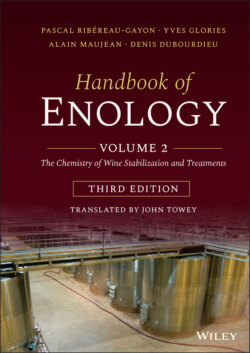Читать книгу Handbook of Enology, Volume 2 - Pascal Ribéreau-Gayon - Страница 54
2.3.1 C3 Polyol: Glycerol
ОглавлениеBesides water and ethanol, glycerol (Table 2.3) is probably the chemical compound with the highest concentration in wine. It is the most important by‐product of alcoholic fermentation. The minimum glycerol concentration in wine is 5 g/l, but it may reach values as high as 15–20 g/l, depending on fermentation conditions (especially must sulfiting levels). Musts from grapes affected by noble rot already contain a few grams of glycerol, which is added to the quantity produced by fermentation.
Glycerol is formed by yeast at the beginning of the fermentation process. It is generally considered to be produced “with the first 50 grams of sugars fermented.” This corresponds to the start of the glyceropyruvic fermentation. The only way for yeast to ensure the reoxidation of the NADH coenzyme + H+ is by reducing dihydroxyacetone to glycerol. At this stage, the acetaldehyde level is too low for this reoxidation to occur while producing ethanol. When must is treated with high doses of SO2, this molecule binds with acetaldehyde, thus increasing the glyceropyruvic fermentation rate and the amount of glycerol formed.
TABLE 2.3 Concentrations of Polyols Found in Wines (Ribéreau‐Gayon et al., 1982)
| Formula | Concentrations(mg/l) | |
|---|---|---|
| Glycerol | CH2OH−CHOH−CH2OH | 5,000–20,000 |
| 2,3‐Butanediol | CH3−CHOH−CHOH−CH3 | 330–1,350 |
| Erythritol | CH2OH−(CHOH)2−CH2OH | 30–200 |
| Arabitol | CH2OH−(CHOH)3−CH2OH | 25–350 |
| Mannitol | CH2OH−(CHOH)4−CH2OH | 90–750 |
| Sorbitol | CH2OH−(CHOH)4−CH2OH | 30–300 |
| meso‐Inositol | (CHOH)6 | 220–730 |
Glycerol in wine may act as a carbohydrate nutrient for the growth of various microorganisms, e.g. the flor yeast in Sherry production (Volume 1, Section 14.5.2).Also, certain detrimental bacteria are capable of breaking down glycerol, with a double dehydration reaction that produces acrolein (Figure 2.5). Acrolein interacts with tannins to reinforce bitterness and is considered a type of microbial spoilage (acrolein spoilage or amertume) (Section 8.3.2).
In view of its high concentration, it was thought that glycerol affected wine flavor, giving an impression of body and softness. In fact, doses much higher than those occurring naturally in wine are required to affect flavor to any significant extent.
